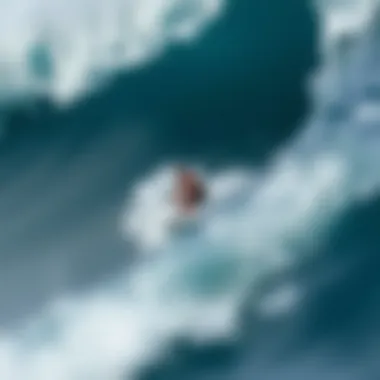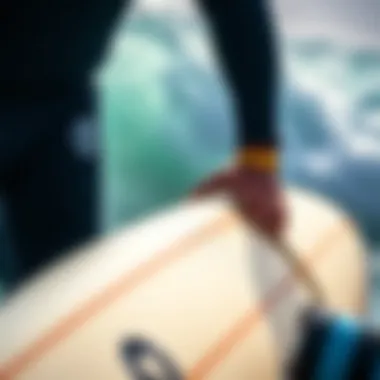Mastering Big Wave Surfing Techniques and Safety


Intro
Jumping into the realm of big wave surfing is akin to stepping onto a high-wire without a safety net; it demands respect, skill, and a splash of daring. Surfers who dare tackle these colossal beauties often find themselves riding not just waves, but their very own fear. This guide aims to equip both novices and seasoned pros with the knowledge and tools to tackle the intimidating task of mastering big swells.
In this detailed exploration, we’ll discuss strategies to perfect wave riding, essential equipment to ensure safety and performance, and delve into the mental aspects crucial for facing the formidable forces of nature. Whether you’re scouting your first break at a local beach, or setting your sights on the legendary waves of Teahupo'o, this resource is crafted to bolster your confidence and refine your technique.
Let’s dive into the essentials of technique and skill, laying a foundation for your journey toward conquering the waves.
Understanding Big Wave Surfing
Big wave surfing is more than just a sport; it’s a lifestyle. It's where adrenaline meets nature’s raw power. Grasping understanding big wave surfing isn’t merely about knowing how to ride the waves; it encompasses a deep comprehension of the ocean's dynamics, techniques for surviving massive swells, and the mental toughness required to face such formidable conditions. This segment of the article provides a crucial foundation for both budding surfers eager to expand their skills and seasoned athletes aiming for mastery.
Defining Big Waves
To grasp the essence of big wave surfing, we first need to define what constitutes a big wave. Generally, a wave is considered ‘big’ when it reaches a height of at least 20 feet. However, local understanding of what makes a wave big often hinges on geographical context. In some areas, like the frigid waters off Northern California, waves of 15 feet may be considered substantial, while in regions with consistently larger swells, the benchmark might be significantly higher, pushing towards 30 feet and beyond. The definition can also be subjective, varying among surfers who measure challenges through personal experience and ability.
The Science of Waves
The science behind waves delves into a confluence of meteorological and oceanographic factors. Waves are predominantly generated by wind, with factors like wind speed, duration, and fetch – the distance over which wind travels across open water – playing vital roles. The energy of a wave increases with the height and can ultimately culminate in spectacular feats of nature when these waves break on a shore.
Understanding how these forces interact gives surfers an edge. For instance, when a storm brews offshore, it generates swells that can travel thousands of miles before reaching the coast, thus yielding great waves. The approach to these waves can vary; the steepness of the wave face, its speed, and the underlying ocean floor (bathymetry) can all influence how a surfer experiences and ultimately rides the swell.
Historical Context
Throughout the years, big wave surfing has evolved dramatically. From humble beginnings, it seems to have been born in Hawaiian culture, where ancient surfers attempted to ride waves with rudimentary wooden boards. Those early days paved the way for modern surfing culture, which saw significant growth during the 20th century with advancements in board design and techniques. The late 1960s and early 1970s saw a pivotal shift as surfers like Greg Noll and later, legends like Eddie Aikau took center stage, pushing boundaries of what is possible. These pioneers set the groundwork for today's extreme sport mentality, making it acceptable to tackle waves that were previously deemed too perilous.
Over the decades, the community of big wave surfers has not only broadened in skill levels, but also in diversity, attracting a wide array of individuals who seek thrills in the ocean’s chaos. To this day, events like the Eddie Aikau Big Wave Invitational pay homage to this history, reminding each surfer of their longstanding connection to the ocean’s wild heart. Understanding this historical context enriches a surfer’s experience, offering a deeper appreciation for their craft.
Essential Techniques for Surfing Big Waves
Understanding the nuances of surfing big waves involves more than just guts and a wetsuit. It’s a dance with nature that requires specific techniques honed through practice and an intimate knowledge of the surf environment. Mastering these essential techniques can not only improve a surfer's performance but also enhance their overall safety and enjoyment in the water. The following elements break down the core skills one needs to conquer those daunting swells successfully.
Paddle Techniques
Paddling is the foundation of getting into position to ride big waves. Effective paddle techniques can make the difference between catching a wave or getting steamrolled by it.
- Body Position: Lay flat on the board, with your stomach pressed against the foam, feet slightly dangling off the sides. This keeps your board trim and balanced.
- Arm Stroke: Use long, rhythmic strokes. Your arms should enter the water at shoulder width, driving back towards the hips. Avoid splashing; smooth movements maintain speed.
- Breathing: Keep a steady pace and don’t hold your breath. Exhale slowly to remain relaxed as you paddle into the waves.
Improving your paddle strength can significantly increase your chances of getting to the wave first, allowing for a more favorable take-off.
Positioning on the Board
Once you’ve paddled into position, how you sit on the board becomes key. Correct positioning can help you maintain balance and speed.
- Weight Distribution: Place your weight evenly across the board. Too much weight on the nose can lead to pearling, where the board digs into the water and you go over the front.
- Foot Placement: For traditional shortboards, the back foot should be closer to the tail while your front foot stabilizes the front. Experiment with foot placement to find what feels natural while maintaining control.
- Timing: Keep an eye on the wave’s peak. Begin to shift your weight as the wave begins to break, preparing for a swift takeoff.
Adapting your stance to the wave’s unique shape can mean the difference between a slick ride and a wipeout.
Taking Off Successfully
The takeoff is an exhilarating moment that can set the tone for the entire ride. Executing it correctly requires a blend of technique and instinct.
- Timing is Everything: Start paddling hard just as the wave approaches. Recognize the sweet spot—where the wave starts to break, and angle your board towards the shore.
- Pop Up: As the wave lifts your board, thrust your body into a crouched position and push up quickly, landing your feet in a stable stance. Practice your pop-up on land to build muscle memory.
- Stay Low: Keep a low center of gravity as you take off, which helps maintain balance as the wave launches you forward.
Having a smooth takeoff can set you up perfectly to ride the wave, so practice is essential here.
Riding the Wave
Once you’ve taken off, controlling your ride is the next challenge. This is where the magic happens.
- Pumping: Use your legs to pump the board up and down the face of the wave, generating speed. Move fluidly to maintain momentum without losing balance.
- Turning: When navigating the wave, initiate turns by leaning into it, distributing your weight appropriately to pivot your board. A quick flick of the back foot can help direct your movement.
- Reading the Wave: Keep your eyes on the wave as it forms and breaks. Understanding its shape helps you maneuver effectively, letting you decide when to ride the barrel or when to kick out.
Incorporating all these techniques allows surfers to maximize their experience, turning potentially overwhelming chaos into a thrilling ride.
"Surfing is not just a hobby; it’s a way of life that connects you deeply with nature."


Each technique—be it paddling, positioning, taking off, or riding—is a piece of the puzzle that must fit together seamlessly. Mastery over these aspects can elevate your surfing from merely catching waves to truly dancing with them.
Equipment Considerations
When it comes to big wave surfing, having the right gear is as essential as knowing how to ride the swell itself. The equipment plays a crucial role not just in performance but also in safety, making it an indispensable element for surfers looking to tackle formidable waves. This section delves into the specific components of surfing gear—boards, wetsuits, and the latest technological advancements—to help you make informed decisions for your big wave adventures.
Choosing the Right Board
Selecting a surfboard that fits your style and the conditions of the wave is vital. Big wave surfboards typically differ from those used in smaller swells; they need to offer enhanced stability and buoyancy. Usually, these boards are longer, wider, and more robust to provide the necessary support when maneuvering through powerful swells. Here are some factors to consider:
- Length and Width: Longer boards give you better paddling speed and help you catch waves more easily. Width can also increase stability.
- Thickness: A thicker board displaces more water, improving buoyancy and allowing for quick rebounds after a steep drop.
- Tail Shape: Different tail configurations can affect how the board responds to waves. A pintail, for instance, offers better hold in bigger waves, while a square tail can provide more maneuverability.
Surfboard selection also involves personal preferences, and it's worthwhile to demo a few before making your investment. You might find that a specially designed board for big waves suits your surfing style better than you anticipated.
Wetsuits and Safety Gear
When diving into the deep end of surfing's most intense conditions, the right wetsuit becomes your second skin. In big wave situations, warmth and flexibility are paramount, ensuring you can stay in the water longer and react quickly to formidable waves.
Key elements of wetsuit consideration include:
- Thickness: Wetsuits come in varied thicknesses, and your choice depends on water temperature. In colder climates, a 4/3 mm or even a 5/4 mm wetsuit might be necessary, while warmer waters can accommodate a thinner suit.
- Fit: A snug fit is essential to minimize water flushing and maximize insulation. Ensure there are no gaps that could allow cold water to rush in.
- Seams: Look for sealed seams, as they prevent water ingress and keep you warmer.
Besides wetsuits, safety gear like impact vests can be a lifesaver in the chaotic surf of big waves. These vests protect your torso from collisions with the board and the ocean floor when you wipe out.
Innovations in Surfboard Technology
The surfing world sees constant evolution as technology advances. Manufacturers are now designing boards that can withstand larger waves while enhancing your overall experience. New materials, surfboard shapes, and fin systems contribute to a higher performance level while keeping safety at the forefront.
- Epoxy and Hybrid Materials: These materials offer increased strength without weighing down the board, giving surfers the durability they need for big waves.
- Flexible Designs: Innovations allow for boards that flex under load and snap back, providing improved control as you ride.
- Fins System: The fin setup can also influence your ride. Removable fin systems allow surfers to customize their board for different conditions and sizes of waves.
The advancements in surfboard technology create an exciting landscape for surf enthusiasts. Staying informed about these changes can help you choose equipment that not only meets your needs but also takes your performance to new heights.
"Equipment is the backbone of any surfer’s journey, especially when mastering big waves. Choosing wisely is key to both safety and performance."
For further information on surfboard types and their specifications, you can check out resources at Wikipedia and Britannica.
Physical and Mental Preparation
When it comes to tackling big waves, physical and mental preparation is as crucial as mastering techniques or selecting the proper equipment. It’s not just about staying afloat; it’s about stamina, resilience, and quick decision-making when the ocean challenges you. Many surfers can underestimate this, but those who excel in big wave surfing understand that their success hinges on how well they prepare their bodies and minds.
Building Strength and Endurance
Big wave surfing demands not only skill but also significant physical strength and endurance. The physicality of paddling through harsh waters, the strength needed during wipeouts, and the stamina required to ride massive swells cannot be overstated. Here are some elements to consider:
- Core Strength: A strong core stabilizes your body while paddling and maneuvering your board. Exercises like planks, Russian twists, and medicine ball throws can significantly develop core strength.
- Cardiovascular Fitness: This is essential for maintaining energy levels during long sessions in the water. Activities like running, cycling, or swimming can enhance your endurance.
- Muscle Power: Engaging in resistance training helps build the muscle power necessary to navigate tough conditions. Focus on compound movements, such as squats and deadlifts, to train multiple muscle groups at once.
Moreover, the need for flexibility shouldn’t be overlooked. Regular stretching routines not only increase range of motion but also assist in preventing injuries. Preparing in this manner sets the foundation for a successful day in the surf.
Mental Conditioning Techniques
The mental aspect of big wave surfing often gets less attention than the physical training, but it can be the difference between conquering a colossal wave and succumbing to fear. Here are some mental techniques that can help you stay focused and calm:
- Visualization: Picture yourself riding the wave perfectly before you enter the water. This mental rehearsal can build confidence and prepare your mind for the actual experience.
- Mindfulness: Practicing mindfulness techniques can help control anxiety and keep your mind clear. Spend some time in meditation or perform breathing exercises, which can lead to enhanced focus when you face daunting waves.
- Goal Setting: Setting realistic, achievable goals can help structure your training and build confidence. Whether it’s paddling further out or mastering a new technique, progress in small steps helps build a robust mentality.
Both physical and mental preparation go hand in hand. The tougher and more well-prepared you are, physically, the better your mind can focus on the waves ahead. This relationship ultimately leads to the kind of fearless surfing that big wave riders aspire to master.
"Prepare your body for the waves, but train your mind to embrace the challenge. It’s the synergy between them that leads to true mastery."
By understanding and executing these preparation strategies, you will find that not only will your capability in the water increase, but the experience of surfing big waves may become far more enjoyable.
Safety Practices in Big Wave Surfing
Surfing big waves presents a unique blend of thrill and danger. The waves can be colossal, and the environment is often unpredictable. Therefore, adhering to stringent safety practices is essential to enjoy the sport while ensuring personal well-being and that of fellow surfers. Understanding safety in this exhilarating aspect of surfing is not just a good habit; it can be the line that distinguishes a successful session from a potentially life-threatening situation.
Understanding Rip Currents
Rip currents are powerful, narrow channels of water that flow away from the shore. They can sweep even the most seasoned surfers out to sea in mere seconds. Recognizing rip currents is crucial for big wave surfers. One of the most effective ways to spot them is by looking for differences in water color. Healthy surf zones often have foamy, frothy water, while rip currents may appear darker and less turbulent. Additionally, look for gaps in waves—these may indicate a channel through which water is rapidly flowing out to deeper waters.


Key Tips to Identify Rip Currents:
- Look for channels or gaps in the breaking waves.
- Notice any differences in wave heights; often, rip currents have smaller waves.
- Check for foam or debris moving away from the shore.
Understanding how to navigate rip currents is equally vital. If caught in one, don't panic. Swim parallel to the shore until you're free of the current, then head back to the beach.
Spotting Hazards in the Water
The ocean is home to various elements that can pose hazards to surfers. Rocks, reefs, and even other surfers themselves can become obstacles. Keeping a keen eye on your surroundings is essential. Before heading out, familiarize yourself with the break zone and be aware of any sudden changes in conditions.
Here are a few hazards to watch out for:
- Sharks: Though sightings are rare, it pays to be aware of your environment.
- Rocks and Reefs: Not only can they be dangerous when paddling, but colliding with them while riding a wave can lead to serious injuries.
- Other Surfers: In crowded conditions, collisions can happen. Keep a safe distance and be respectful of others’ right of way.
Buddy System and Emergency Protocols
Surfers should never be alone in challenging conditions. The buddy system is a safety practice that can save lives. Having a partner in the water ensures that someone is always keeping an eye out for you. Moreover, communication about exit plans, potential hazards, and emergency procedures can make a world of a difference.
Establishing Emergency Protocols:
- Regular Check-ins: Make sure to communicate frequently with your buddy. A simple wave or nod can ensure that both of you are safe.
- Emergency Plans: Discuss what to do in case of injury or distress. Knowing each other's limitations can help you respond effectively.
- Signal for Help: If you're in trouble, raise your hand to signal assistance. Make this a predetermined signal between you and your buddy.
“In the chaos of the water, safety should remain a steadfast priority.”
By understanding rip currents, spotting hazards in the water, and advocating for a buddy system, surfers can mitigate risks effectively. Safety practices in big wave surfing not only enrich your surfing experience but also help uphold the integrity of the surf community as a whole.
For deeper insights into surf safety, check out resources from Surf Lifesaving and National Oceanic and Atmospheric Administration.
Training Regimens for Big Wave Surfers
Training regimens are vital for anyone serious about conquering big waves. Surfing is not merely about riding; it’s a test of physical stamina, mental resilience, and specific skills that enhance performance when faced with massive swells. A well-structured training program helps surfers build essential attributes that will allow them to thrive on challenging waves while minimizing risks.
While it might be tempting to focus solely on surf time, effective training goes beyond that. It combines strength training, cardiovascular workouts, flexibility exercises, and mental conditioning. Each component plays a role in meeting the unique challenges of big wave surfing.
Routine Development
Developing a training routine involves setting clear, achievable goals that align with one's surfing aspirations. It’s important for surfers to integrate workouts into their schedules, making sure they stay consistent throughout the year. A standard routine might include:
- Strength Training: Emphasize core stability and upper body strength to help with paddling and pop-ups.
- Conditioning: Incorporate seaworthy activities like swimming to build endurance and improve lung capacity.
- Flexibility: Yoga or stretching sessions can be crucial for preventing injuries.
When designing a routine, the focus should also be on periodization, adjusting the intensity and volume of workouts at different times of the year, especially if there are specific big wave seasons. This will make sure the body is primed and ready for those larger swells. Diversifying the workouts keeps them engaging, making it less likely that one will hit a plateau.
Cross-Training Activities
Cross-training is a game-changer for surfers. It lets them sharpen their overall athletic abilities through various complementary sports or activities. Engaging in different disciplines can enhance aspects of surfing without the repetitive strain associated with surf training alone. Here are some effective cross-training activities:
- Stand-Up Paddleboarding (SUP): This enhances balance and engages core muscles in a way that's similar to surfing but with less impact.
- Running or Cycling: These activities boost overall cardiovascular fitness, which is essential for stamina in the water.
- Martial Arts: Disciplines like Brazilian Jiu-Jitsu or Muay Thai can sharpen reflexes and increase body awareness.
Utilizing cross-training not only builds versatility but also keeps motivation high. Surfers may find that they perform better in the water as they develop skills outside their traditional surf training.
Motivation and determination are like the ocean’s tide; they ebb and flow. Creating a robust training regime ensures that when those massive waves roll in, you're ready to tackle them head-on.
Players against the elements won’t just be those who surf but also those who prepare rigorously for what nature has to offer. With the right routine and auxiliary activities, a surfer can refine their skills, improve overall fitness, and have the mental fortitude needed when facing the daunting challenge of big waves.
Notable Big Wave Surfing Locations
When it comes to big wave surfing, certain locations are etched into the hearts and minds of surfers worldwide. These spots offer not only giant swells but also a blend of unique cultural significance, environmental factors, and a sense of community among surfers. Diving into notable big wave surfing locations is not just an exploration of where to ride the waves; it's a journey to understand the spirit of the sport itself. Each destination boasts a distinct character that shapes the experience for surfers, drawing them back time and again.
Pipeline, Hawaii
Nestled on Oahu's North Shore, Pipeline is more than just a famous surfing spot; it's a rite of passage for serious surfers. Known for its powerful, hollow waves that break over a shallow reef, the Pipeline offers both beauty and danger. Surfers are drawn here not merely by the thrill but by the rich history of surf culture that this location embodies.
Some key considerations when approaching Pipeline include:
- Wave Shape: Understanding the unique wave formations at Pipeline is crucial. The waves are often fast and hollow, making for thrilling rides but also requiring precise timing and positioning.
- Local Knowledge: The community around Pipeline values respect. Gaining knowledge from local surfers can enhance your experience and safety.
- Safety Measures: Awareness of the reef below and potential hazards is essential. Surfers should be prepared for wipeouts and practice their swimming skills.


Teahupoʻo, Tahiti
Teahupoʻo is often regarded as one of the heaviest waves in the world, and with good reason. Located on the south coast of Tahiti, it attracts surfers looking to test their mettle against its thick, heavy barrels. What sets Teahupoʻo apart from other big wave destinations is its intense power and the conditions required for a successful surf.
Surfers should consider:
- Stunning Surroundings: The beauty of the landscape is often as breathtaking as the waves themselves. Surfers should take in the surroundings while waiting for the perfect swell.
- Preparation and Experience: Teahupoʻo is not for the faint-hearted. It requires a level of experience that many novice surfers may not yet possess.
- Local Rules: It's important to respect local customs and rules, as the Tahitian culture places strong emphasis on community and respect in the water.
Mavericks, California
Mavericks, located just north of Half Moon Bay, is famous for its colossal waves that can reach over 25 feet on the right conditions. The combination of underwater topography, wind, and swell direction creates a unique surf experience that attracts both seasoned riders and daring challengers.
Key points to consider:
- Winter Season: The best time to experience immense waves is during the winter months, when ocean swells are at their peak.
- Dangerous Currents: Mavericks can pose serious threats due to rip currents and rocky formations. Surfers need to be vigilant and aware of their surroundings.
- Big Wave Events: The annual Mavericks contest draws attention and is a showpiece of the skill required for surfing big waves, fostering a strong sense of camaraderie among competitors.
Jaws, Maui
Known as "Peahi," Jaws is revered as one of the most impressive big wave surf spots globally. With its monster waves that can reach heights of up to 60 feet, it has become a pilgrimage for surfers seeking the ultimate thrill. The raw power of the ocean at Jaws commands respect from all who dare to surf its formidable waves.
Considerations for surfers at Jaws include:
- Skill Level: Only highly skilled surfers should attempt to ride Jaws, as the conditions can be extreme.
- Equipment: The vast waves and fierce conditions necessitate specialized equipment, including tow-in surfing to handle the size and power.
- Community and Culture: The tight-knit surfer community at Jaws exemplifies the spirit of adventure and camaraderie that characterizes big wave surfing.
"When you master the elements at these locations, you become part of a legacy that stretches across generations of surfers."
Each of these locations presents unique challenges and rewards for surfers, and understanding their specific environments can lead to a more fulfilling surfing experience. The thrill of conquering a wave at Pipeline or surviving a ride at Teahupoʻo isn't just about skill—it’s about embracing the culture, the community, and the essence of big wave surfing itself.
For more insights into surfing big waves, visit Wikipedia or check out forums like Reddit.
Embrace the waves, respect the water, and enjoy the ride!
The Culture of Big Wave Surfing
When it comes to big wave surfing, there’s more than just the rush of riding the waves; there's an entire culture surrounding this adrenaline-fueled sport. This culture is a tapestry woven from threads of shared experiences, respect for the ocean, and a strong sense of community among surfers. The essence of being a big wave surfer transcends mere individual skill. It encompasses a collective understanding, a deep-seated camaraderie, and a shared commitment to the ocean and each other.
In this section, we will delve into the importance of community, the camaraderie built among surfers, and the influence of competitions in this unique culture. Understanding these elements is crucial for anyone looking to truly master the art of big wave surfing.
Community and Camaraderie
In the surfing world, especially in big wave circles, the concept of community is paramount. Surfers often describe it as a family—one that is not bound by blood but by shared passions and experiences. The ocean serves as the ultimate equalizer, stripping everyone down to their core loves and fears. Surfers often find themselves in situations that demand decisions made swiftly, creating bonds that can last a lifetime.
- Shared Experiences: Whether it’s waiting for the ideal swell or sharing tales after a near-miss, these moments strengthen friendships. Big wave surfers often recall experiences that are not just about the ride but about the people they shared it with.
- Mentorship: Seasoned surfers often take newcomers under their wings, passing on knowledge and skills. This mentorship is vital in the world of big wave surfing, where the risks are high, and knowing what to do can save lives.
- Respect for the Ocean: There’s an unspoken rule among surfers—to respect the ocean and its power. This mutual understanding develops trust not only within the surfing community but also with the sea itself.
"In the ocean, nothing is guaranteed. It demands respect, and in return, fosters a mighty fellowship among those who dare to ride its waves."
The Role of Competitions
Competitions are not just events; they are pivotal in shaping the big wave surfing culture. They provide a platform that showcases talent, determination, and resilience, pushing surfers to elevate their skills and understand the nuances of surfing some of the heaviest waters in the world. Competitions also offer visibility, and they play a significant role in the careers of many aspiring surfers.
- Opportunity to Shine: Events like the Big Wave Tour allow surfers to compete against the best, getting their names out there and potentially securing sponsorships. These competitions offer a chance to showcase not just skill but creative expression on waves that scare most away.
- Community Building: Competitions also foster a spirit of camaraderie. Surfers not only compete against each other but also cheer each other on, sharing in both triumphs and disappointments. This sense of sportsmanship reflects the deep respect shared among the riders.
- Sustainability and Awareness: Many competitions are now incorporating themes of environmental awareness. Awareness talks and sustainable practices are becoming standard features, reminding the surfing community of their responsibility in preserving the oceans they cherish.
As we look to the future of big wave surfing, it's clear that the culture surrounding it is essential for both individual growth and the collective advancement of the sport. Understanding this community can truly help any surfer on their journey to mastering the art of the waves.
The Future of Big Wave Surfing
The future of big wave surfing is a dynamic landscape shaped by technology, environmental considerations, and evolving athlete techniques. As one of the most exhilarating sports, it demands both respect and foresight. Understanding where big wave surfing is headed offers insights into safety improvements, innovative equipment, and the ongoing quest to harmonize with nature. As the climate changes and the ocean reacts, surfers must adapt accordingly, making it a critical area of focus.
Emerging Trends in Surfing Techniques
In this ever-evolving sport, techniques aren't stagnant; they grow as surfers push their limits. Factors such as enhanced board design and improved paddling methods are setting the stage for a new generation of surfing. Some notable trends include:
- Foil Technology: Surfers are increasingly using hydrofoils, which lift the board out of the water, creating less drag and allowing for quicker maneuvers. The ability to pop up and glide over the wave is revolutionary in the quest for speed and control.
- Video Analysis: Surfer training now often incorporates technology. Athletes review footage of their rides, analyzing body movements and wave interactions. This precision-led approach to improvement highlights a dedication to continual learning, ensuring surfers refine their technique effectively.
- Cross-Disciplinary Training: Athletes are taking cues from other fields. Whether it’s yoga for enhancing flexibility or breath-hold training borrowed from free divers, surfers are expanding their skillsets beyond traditional methods, which provides a more rounded arsenal in tackling big waves.
Environmental Considerations
As we look to the future of big wave surfing, the environment takes on increasing importance. Surfers are not just participants in this sport; many are becoming stewards of the ocean. Key considerations for the future include:
- Climate Change Impacts: Shifting ocean temperatures and changing weather patterns affect wave formation and surf conditions. Surfers need to adapt, recognizing how global warming shifts swells and affects their safety.
- Sustainability Efforts: Companies are beginning to lean toward eco-friendly gear production—such as boards made from recyclable materials. Surfers are increasingly making purchases based on a brand's commitment to sustainability.
- Community Initiatives: Beach clean-ups and environmental advocacy are becoming regular practices within surfing culture. Many surfers collaborate with local groups to promote ocean health. As the sport grows, so does the responsibility to ensure the environment in which they thrive remains intact for future generations.
"As surfers, we have the unique opportunity to ride the waves of change—not just in terms of our techniques, but also in how we care for our oceans."
In summary, the future of big wave surfing holds promise but also significant responsibility. Adaptation to emerging techniques, combined with a strong commitment to environmental stewardship, will be essential as the surf culture navigates these evolving challenges.







